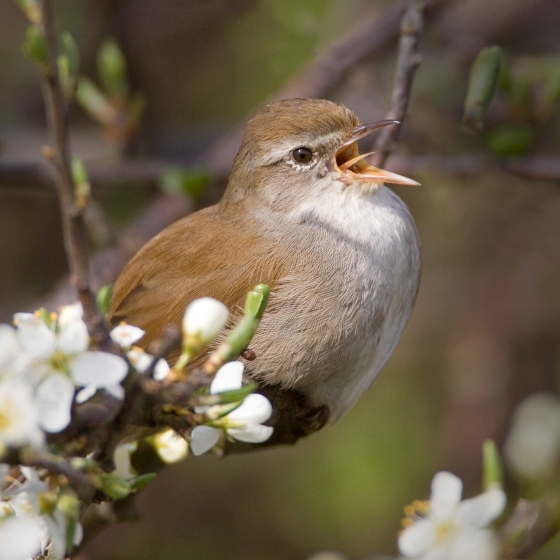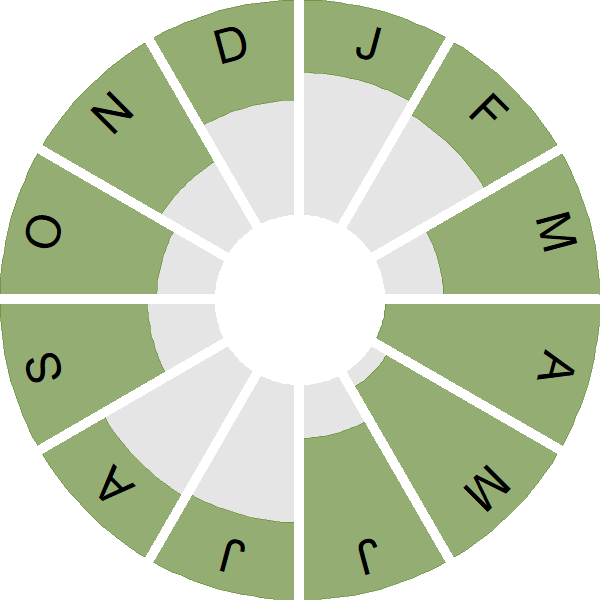Cetti's Warbler

Introduction
The loud song of this small brown bird erupts from scrub and reedbeds, announcing a Cetti's Warbler's presence to passersby.
The Cetti's Warbler has undergone range expansion in recent decades. It first bred in Britain in the early-1970s, in Kent. Its range has since moved northwards and it now breeds through to northern England and Wales, although in fairly discrete areas. The winter range is similar. It is likely that the Cetti's Warbler's colonisation of Britain has been facilitated by climatic warming. As the species' range has expanded, its UK population has also risen, although there have been signs of a downturn in recent years. Cetti's Warblers are rare vagrants on the island of Ireland.
Cetti's Warblers inhabitat reedbeds and dense, scrubby vegetation, typically near water. Uniquely among British-breeding birds, Cetti's Warblers have only 10 tail feathers (instead of the usual 12). Females lay bright red eggs, typically in clutches of four or five, and may produce two broods a year. Cetti's Warblers largely eat small insects.
- Our Trends Explorer gives you the latest insight into how this species' population is changing.

Key Stats
Identification
Songs and Calls
Song:
Call:
Alarm call:
Begging call:
Status and Trends
Conservation Status
Population Change
Cetti's Warbler was first recorded in Britain as recently as 1961, as part of its range expansion across northwest Europe (Bonham & Robertson 1975). Colonisation, which began in Kent in 1972 or 1973, continued to be monitored annually by RBBP until 2016. Numbers and breeding range increased spectacularly during the first 12 years, with Norfolk and Dorset gradually overtaking Kent as the main host counties (Gibbons et al. 1993, Wotton et al. 1998). Populations in milder regions continued to grow, but overall the UK population fell by over a third between 1984 and 1986. In the absence of severe winters during 1986-2009, increase and range expansion continued. The first breeding records north of the Humber were made in 2006 (Holling & RBBP 2009).
Much constant-effort ringing takes place in prime Cetti's Warbler habitat; despite the comparative rarity of this species, therefore, CES population and productivity indices were already available by the early 2000s (Robinson et al. 2007a) and the species has also recently become sufficiently widespread to enable BBS trends to be produced. There has been an increase across Europe since 1989 (PECBMS: PECBMS 2020a>).
Distribution
The explosive song of the Cetti's Warbler means that fieldworkers will have overlooked few breeding sites, although proving breeding is difficult. In 2007–11 Cetti's Warblers occupied lowland wetlands in a broad but discontinuous band around the coast and are relatively common in certain river basins, such as the Thames, the Hampshire Avon and the Great Ouse. Other lowland areas of England and Wales are also occupied, but at lower density.
Occupied 10-km squares in UK
2007/08–10/11
or view it on Bird Atlas Mapstore.
2008–11
or view it on Bird Atlas Mapstore.
European Distribution Map
Distribution Change
Since first breeding in the UK in 1973
Change in occupied 10-km squares in the UK
from 1981–84 to 2007–11
or view it on Bird Atlas Mapstore.
from 1968–72 to 2008–11
or view it on Bird Atlas Mapstore.
Seasonality
Cetti's Warbler is recorded year-round, with distinct peaks in detection in spring when singing and in late autumn.
Weekly pattern of occurrence
The graph shows when the species is present in the UK, with taller bars indicating a higher likelihood of encountering the species in appropriate regions and habitats.

Movement
Britain & Ireland movement
Foreign locations of birds ringed or recovered in Britain & Ireland
Dots show the foreign destinations of birds ringed in Britain & Ireland, and the origins of birds ringed overseas that were subsequently recaptured, resighted or found dead in Britain & Ireland. Dot colours indicate the time of year that the species was present at the location.
- Winter (Nov-Feb)
- Spring (Mar-Apr)
- Summer (May-Jul)
- Autumn (Aug-Oct)

European movements
EuroBirdPortal uses birdwatcher's records, such as those logged in BirdTrack to map the flows of birds as they arrive and depart Europe. See maps for this species here.
The Eurasian-African Migration Atlas shows movements of individual birds ringed or recovered in Europe. See maps for this species here.
Biology
Productivity and Nesting
Nesting timing
Egg measurements
Clutch Size
Survival and Longevity
Survival is shown as the proportion of birds surviving from one year to the next and is derived from bird ringing data. It can also be used to estimate how long birds typically live.
View number ringed each year in the Online Ringing Report.
Lifespan
Survival of adults
Biometrics
Wing length and body weights are from live birds (source).
Wing length
Body weight
Ring Size
Classification, names and codes
Classification and Codes
- Order: Passeriformes
- Family: Cettiidae
- Scientific name: Cettia cetti
- Authority: Temminck, 1820
- BTO 2-letter code: CW
- BTO 5-letter code: CETWA
- Euring code number: 12200
Alternate species names
- Catalan: rossinyol bord comú
- Czech: cetie jižní
- Danish: Cettisanger
- Dutch: Cetti's Zanger
- Estonian: kalda-rädilind
- Finnish: silkkikerttunen
- French: Bouscarle de Cetti
- German: Seidensänger
- Hungarian: berki poszáta
- Icelandic: Blæsöngvari
- Irish: Ceolaire Cetti
- Italian: Usignolo di fiume
- Latvian: cetija
- Lithuanian: placiauodege cetija
- Norwegian: Cettisanger
- Polish: wierzbówka (zwyczajna)
- Portuguese: rouxinol-bravo
- Slovak: cetia západná
- Slovenian: svilnica
- Spanish: Cetia ruiseñor
- Swedish: cettisångare
- Welsh: Telor Cetti
Research
Causes of Change and Solutions
Causes of change
It is likely that the population increases and range expansion of Cetti's Warbler were, at least partly, driven by climate change, with subsequent decreases in population caused by severe winter weather.
Further information on causes of change
Analysis of CES data shows that the rate of productivity has remained constant, and the initial steep increases are likely to have been aided by high productivity and overwinter survival, with population growth slowing as density-dependent effects started to occur, and severe weather also reduced numbers in some winters (Robinson et al. 2007a).
Information about conservation actions
This recent colonist is currently increasing its abundance and range in the UK, and hence no specific conservation actions are currently required. Actions to maintain and create wetland habitats for other species are also likely to benefit this species, the population of which "may be approaching its maximum size under current conditions" (Robinsonet al. 2007a). Reedbeds are particularly important for this species during the late summer and autumn (Araujo et al. 2016) and hence provision of this habitat at sites with wetland features may to help support and attract Cetti's Warblers.
More Evidence
More evidence from Conservation Evidence.com
Partners
Citing BirdFacts
If you wish to cite particular content in this page (e.g. a specific value) it is best to use the original sources as linked in the page. For a more general citation of the whole page please use: BTO (20XX) BirdFacts Species: profiles of birds occurring in the United Kingdom. BTO, Thetford (www.bto.org/birdfacts, accessed on xx/xx/xxxx).

